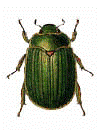Museum, University of Nebraska State
Document Type
Article
Date of this Version
1-2007
Abstract
Brook trout Salvelinus fontinalis and other salmonids in Appalachia typically inhabit headwater watersheds, where food resources may limit growth. We monitored the feeding trends of a brook trout population in central Appalachia over the course of 2 years to determine variation in feeding intensity and important prey items. One terrestrial beetle family, Scarabaeidae, provided a disproportionate amount of energy during the only time of year when brook trout were feeding substantially above maintenance ration. Scarab beetles contributed 39.6% of all energy consumed during May and June of both years, though the number of fish with one or more scarabaeids present in the stomach varied by month (22.2-51.7%). The species composition of scarab beetles consumed suggested that four species are of particular importance. Our findings imply that scarabaeids represent a considerably important prey taxon for brook trout in the region. Considering the foraging habits of the scarabaeid species in question, the phenomenon we witnessed probably occurs throughout Appalachia.



Comments
Published in Transactions of the Amencan Fisheries Society 136:1 (January 2007), pp. 177-184. DOI: 10.1577/T06-057.1 Copyright (c) 2007 by the American Fisheries Society. Used by permission.